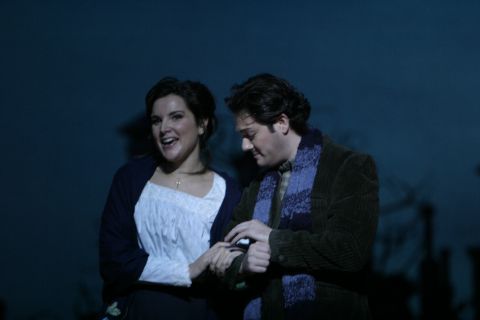|

Artful Phrasing
'La bohème' at Los Angeles Opera,
reviewed by MARIA NOCKIN
Giacomo Puccini's La bohème is just one of many works for the stage that have evolved out of Henry Mürger's original stories about life among struggling young people in nineteenth century Paris. His work is immediate and compelling because he was describing a life that he knew and people with whom he was associated. Mürger (1822-1861) actually tried and failed to earn a living as a painter and a poet. He also worked as a messenger for a lawyer and was the secretary to a Russian diplomat before finally being asked to write human interest stories for the satirical and cultural journal, Le Corsaire-Satan. His witty, autobiographical Scènes de la Vie de Bohème were serialized in that magazine between 1845 and 1849. Eventually, with the help of playwright Théodore Barrière, he fashioned them into a play that caused a sensation in Paris. It was this play that inspired the operas of Puccini and Leoncavallo.

Virginia Tola and Arturo Chacón-Cruz in 'La bohème' at Los Angeles Opera. Photo © 2007 Robert Millard
|
Puccini, who was at that time best known for Manon Lescaut, had his libretto written by dramatist Luigi Illica (1857-1919) and poet Giuseppe Giacosa (1847-1906). Leoncavallo, who had already composed his most famous opera Pagliacci, wrote his own libretto. He made Marcello his leading tenor instead of Puccini's choice, Rodolfo. Puccini's work was premièred in Turin in 1896 where it had a modest success that soon began to grow as the opera was seen in other Italian cities. Leoncavallo's La bohème was first seen at La Fenice in Venice the following year, but it never developed a substantial following among the public.
Continue >>
Copyright © 9 December 2007
Maria Nockin, Arizona USA

|

